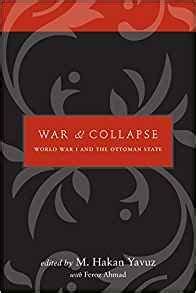War and Collapse: World War I and the Ottoman State
War and Collapse: World War I and the Ottoman State Reviewed by: Ian Oxnevad, PhD candidate at University of California, Riverside Voluminous in scope and depth, War and Collapse: World War I and the Ottoman State is nothing short of essential for scholars of international relations, Middle East politics, security studies, and historians interested in issues of imperial collapse. Compiling chapter submissions from an array of authors, Yavuz and Ahmad compiled an intricate compendium of analyses covering the Ottoman endgame. With WWI often under-examined in its significance, and the ending of the Ottoman Empire frequently depicted as a starting point of the modern Middle East, War and Collapse fills an existing void in a single volume. Intended to “provide a dialogue” between existing scholarship on WWI and Ottoman specialists, the book also explores how various “ethnic and national groups” oriented in a rapidly changing geopolitical environment (1). Ranging from geographically focused sections on the Arab provinces to the Balkans, Russian involvement in the Caucuses, the inner politics of the Turkish nationalist movement, foreign policy, and post-war retrospectives, the book offers material for specialists from multiple fields. The breadth of War and Collapse easily places it as a first go-to source for scholars and students seeking entry to a number of topics related to the end of the Ottoman state. Discussions of nationalism, examinations of proxy wars, high diplomacy, and genocide populate the volume. Saturated with historical detail, the book fodders any examination of the war and its context with illustrations of the roles played by key political and military figures involved in the conflict. The details included in the book’s analytical narratives on postwar population transfers, the Armenian genocide, and often overlooked involvement of Germany and Russia in shaping the future of post-Ottoman provinces are among a number of the work’s strengths for the historian. For the political scientist, Yavuz’s volume is analytically important for its treatments on various sub-national populations in the Ottoman domain. Analytically nuanced, Kurdish groups, Armenians, Arabs, and other populations are treated as separate actors as well as subjects of the Ottoman state. This differentiation not only allows for discovering origins of contemporary conflicts in the WWI era, but also carries the added benefit of appreciating the polities involved in the context of multiple combative empires rather than states. For the political scientist, these layers illustrate that the Ottoman Middle East was not a political monolith prior to the postwar treaties of Sevres or Lausanne so much as a networked domain of identities administered by the Ottoman Empire. The weaknesses of War and Collapse are reflections of the work’s strength. For all of its dripping detail and scope, the piece’s chapters lack a central coherent takeaway. For example, the book’s second to last chapter characterizes the Allies’ diplomatic attempts to divide Anatolia into European mandates similar to those founded in the Levant as uniquely Orientalist in nature (1283-1314). Such arguments are incongruous with the whole of the volume, and remove the Ottoman collapse from the context of the dismantling of multiple empires at the time. Additionally, the concluding chapter (1315-1333) borders upon the metaphysical and is better suited to a standalone article for another field than to be included in the volume. This lack of a theoretical center can be largely forgiven, given the complexity and coverage of the book’s analyses and the different phenomena it covers. On the whole, Yavuz and Ahmad succeed in the creation of a volume of considerable academic utility. Political scientists will find in-depth discussions and details related to Great Power competition, proxy war, and domestic governance in the context of empire. Historians of the period will benefit from the inclusion of analytical lenses provided by international relations and the interconnections between Ottoman affairs and the global conflict that comprised WWI. Post-colonial scholars would be well-reminded by the volume that the dismantling of the Ottoman Empire was not uniquely a Middle Eastern occurrence, so much that the end of a centuries-old polity occurred in conjunction with the same phenomenon elsewhere at the time. Finally, students of the contemporary Middle East will take away the understanding that today’s politics in the region are not new, nor unique. The student who is new to the study of the Middle East will come away knowing that the hallmark political struggles that characterize tensions related to Kurdistan, Armenian-Turkish relations, and the role of Islam and its use for political power have long traditions in the region. Scholars and students of the modern Middle East and those interested in the Ottoman era cannot do without this volume. Despite its complexity, and the relative absence of a theoretical center, the piece fills an interdisciplinary void between regional specialists, international relations scholars, historians, and political theorists. |



